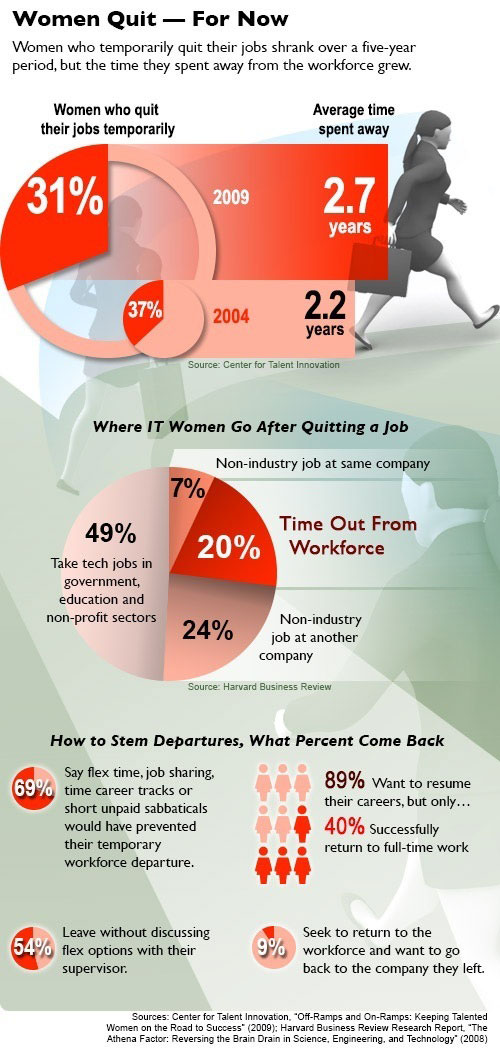A decade ago, women felt emboldened to give up high-profile, high-paying jobs in order to stay home and devote their time to raising children and other family matters. This
Opt-Out Generation now
wants back-in. For women in IT, the journey back into the workforce can be more challenging than the path women face in other industries. For starters, technology changes at such a rapid pace that engineering skills can quickly become perishable. Additionally, since women
make up a fraction of the tech workforce, they can often feel isolated. So, coming back to an environment where their mostly male colleagues haven’t taken time off from their careers can make them feel ever more alone.

Exit, Stage Left
Most women who temporarily leave IT do so to raise their families, according to long-time Silicon Valley career consultant Betsy Collard. "These women leave when they are somewhere in their 30s and often come back when their kids are older and back in school, so they're usually around their 40s when they return," she says. "When they leave to raise their families, I think few keep up with their skills." That decision to forgo maintaining their skills may, in part, be based on the assumption that they aren't planning to return when they give notice to their manager. According to the Center for Talent Innovation's 2009 report
Off-Ramps and On-Ramps: Keeping Talented Women on the Road to Success, women across all industries often fail to discuss plans with their manager before quitting. “Very few women, 50 percent, have a conversation with their manger before they leave," says Laura Sherbin, Director of Research for the center. "They make a short-term decision, as in 'I don't want to be working right now,' that has very long-term consequences. It can be very difficult to get back into the workforce."
Enter, Stage Right
One of the greatest hurdles in returning to IT work is facing a changed landscape. Tech moves fast, with trends and required skill sets morphing in what often feels like a nanosecond. Facebook, for example, was founded less than 10 years ago and put social media front and center.
Apple's iPhone hit the market roughly six years ago and brought a crushing demand for mobile third-party apps. Google Glass is expected to drive wearable computing to a new level. While classes or certifications are one way to update skills, they alone can fall short of what companies seek. "Employers are looking for people with experience and not just someone with training," notes Collard. "Some women will volunteer in the schools and help them to set up databases, for example, but that type of work may not translate into a software developer job." If a woman is out of the workforce for an extended period of time -- like a decade – her best move may be to seek a position that's aligned with, but not exactly like, the position she last held, says Reena Mittal, owner of recruiter RM Professional Services. "A majority of women do an extension of what they were previously doing," Mittal says. As an example, she cites a friend who moved from networking to Web applications. One of the best strategies to address all this is to network. Collard advises women to never lose contact with former colleagues. "They can keep you up to date on what is going on in the industry, the trends and the direction where things are headed," she says.






